tow Oldsmobile Aurora 1998 s User Guide
[x] Cancel search | Manufacturer: OLDSMOBILE, Model Year: 1998, Model line: Aurora, Model: Oldsmobile Aurora 1998Pages: 380, PDF Size: 19.75 MB
Page 92 of 380
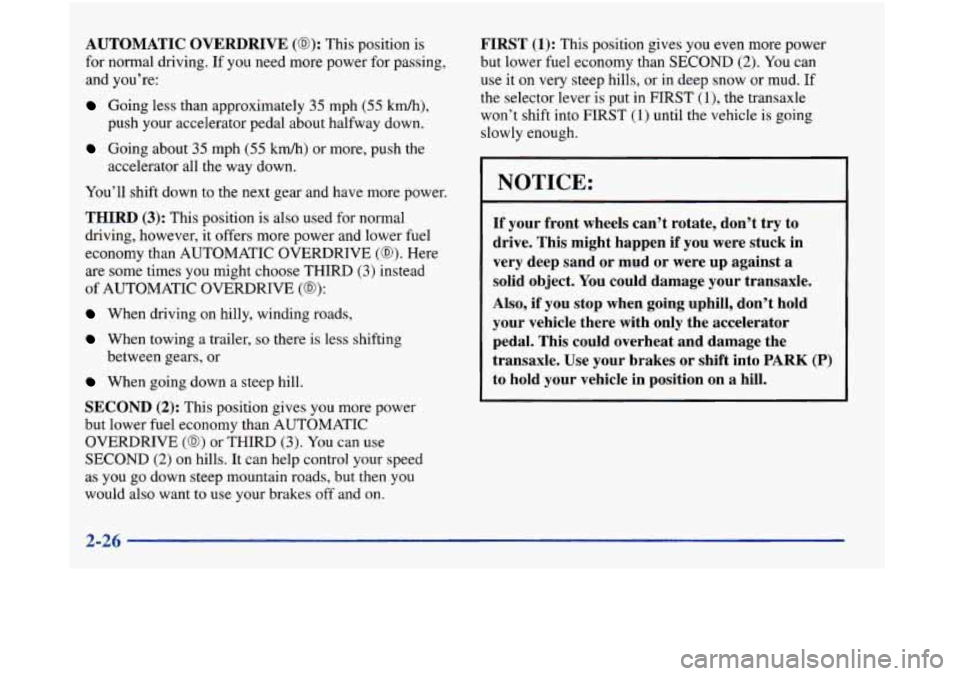
AUTOMATIC OVERDRIVE (0): This position is
for normal driving. If you need more power for passing,
and you’re:
Going less than approximately 35 mph (55 km/h),
push your accelerator pedal about halfway down.
Going about 35 mph (55 kmh) or more, push the
accelerator all the way down.
You’ll shift down to the next gear and have more power.
THIRD (3): This position is also used for normal
driving, however, it
offers more power and lower fuel
economy than AUTOMATIC OVERDRIVE
(0). Here
are some times you might choose THIRD
(3) instead
of AUTOMATIC OVERDRIVE
(@):
When driving on hilly, winding roads,
When towing a trailer, so there is less shifting
When going down a steep hill.
SECOND (2): This position gives you more power
but lower fuel economy than AUTOMATIC
OVERDRIVE
(a) or THIRD (3). You can use
SECOND
(2) on hills. It can help control your speed
as you go down steep mountain roads, but then you
would also want to use your brakes off and on.
between gears,
or
FIRST (1): This position gives you even more power
but lower fuel economy than SECOND
(2). You can
use it on very steep hills, or in deep snow or mud.
If
the selector lever is put in FIRST (l), the transaxle
won’t shift into FIRST
(1) until the vehicle is going
slowly enough.
NOTICE:
If your front wheels can’t rotate, don’t try to
drive. This might happen if you were stuck in
very deep sand or mud or were up against
a
solid object. You could damage your transaxle.
Also, if you stop when going uphill, don’t hold
your vehicle there with only the accelerator
pedal. This could overheat and damage the
transaxle. Use your brakes or shift into
PARK (P)
to hold your vehicle in position on a hill.
2-26
Page 94 of 380
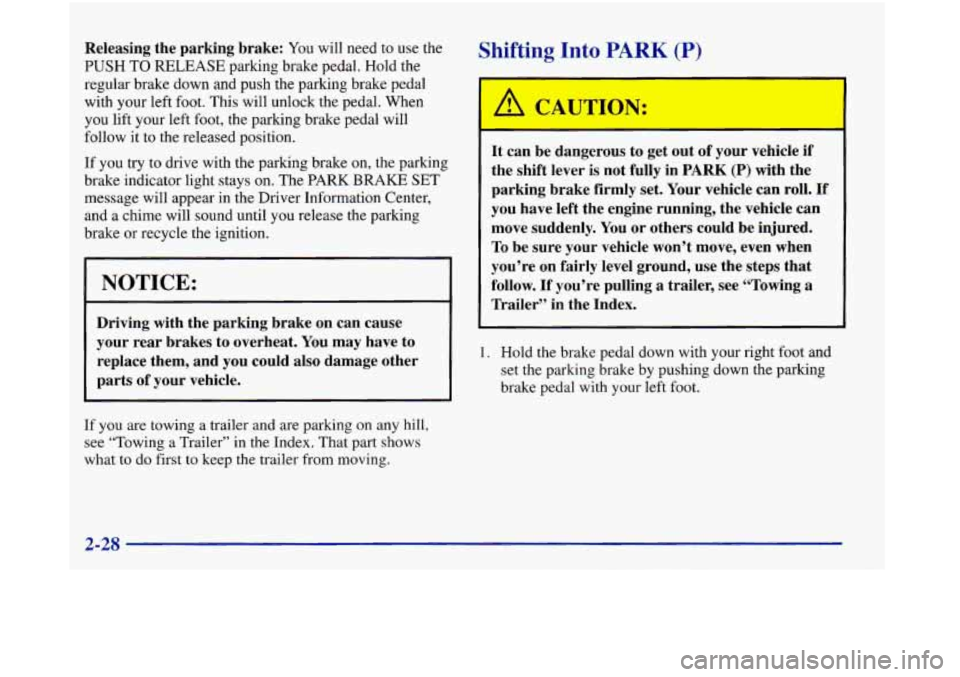
Releasing the parking brake: You will need to use the
PUSH TO RELEASE parking brake pedal. Hold the
regular brake down and push the parking brake pedal
with your left foot. This will unlock the pedal. When
you lift your left foot, the parking brake pedal will
follow
it to the released position.
If you try to drive with the parking brake on, the parking
brake indicator light stays
on. The PARK BRAKE SET
message will appear in the Driver Information Center,
and
a chime will sound until you release the parking
brake or recycle the ignition.
NOTICE:
Shifting Into PARK (P)
Driving with the parking brake on can cause
your rear brakes to overheat. You may have to
replace them, and you could also damage other
parts of your vehicle.
1
If you are towing a trailer and are parking on any hill,
see “Towing a Trailer” in the Index. That part
shows
what to do first to keep the trailer from moving.
It can be dangerous to get out of your vehicle if
the shift lever is not fully in PARK (P) with the
parking brake firmly set.
Your vehicle can roll. If
you have left the engine running, the vehicle can
move suddenly. You or others could be injured.
To be sure your vehicle won’t move, even when
you’re on fairly level ground, use the steps that
follow. If you’re pulling a trailer, see “Towing a
Trailer” in the Index.
1. Hold the brake pedal down with your right foot and
set the parking brake by pushing down the parking
brake pedal with your left foot.
2-28
Page 95 of 380

2. Move the shift lever into PARK (P) as follows:
Hold in the button on the lever.
Push the lever all the way down toward the front
of your vehicle.
3. Turn the ignition key to LOCK.
4. Remove the key and take it with you. If you can
leave your vehicle with the ignition key in your
hand, your vehicle is in
PARK (P).
Leaving Your Vehicle With the
Engine Running
It can be dangerous to leave your vehicle with the
engine running. Your vehicle could move
suddenly if the shift lever is not fully in
PARK (P)
with the parking brake firmly set. And, if you
leave the vehicle with the engine running, it could overheat and even catch fire. You or others could
be injured. Don’t leave your vehicle with the
engine running unless you have to.
If you have to leave your vehicle with the engine
running, be sure your vehicle is
in PARK (P) and your
parking brake is firmly set before you leave
it. After
you’ve moved the shift lever into PARK (P), hold the
regular brake pedal down. Then,
see if you can move the
shift lever away from PARK (P) without first pushing
the button.
If you can, it means the shift lever wasn’t fully locked
into PARK (P).
Page 99 of 380
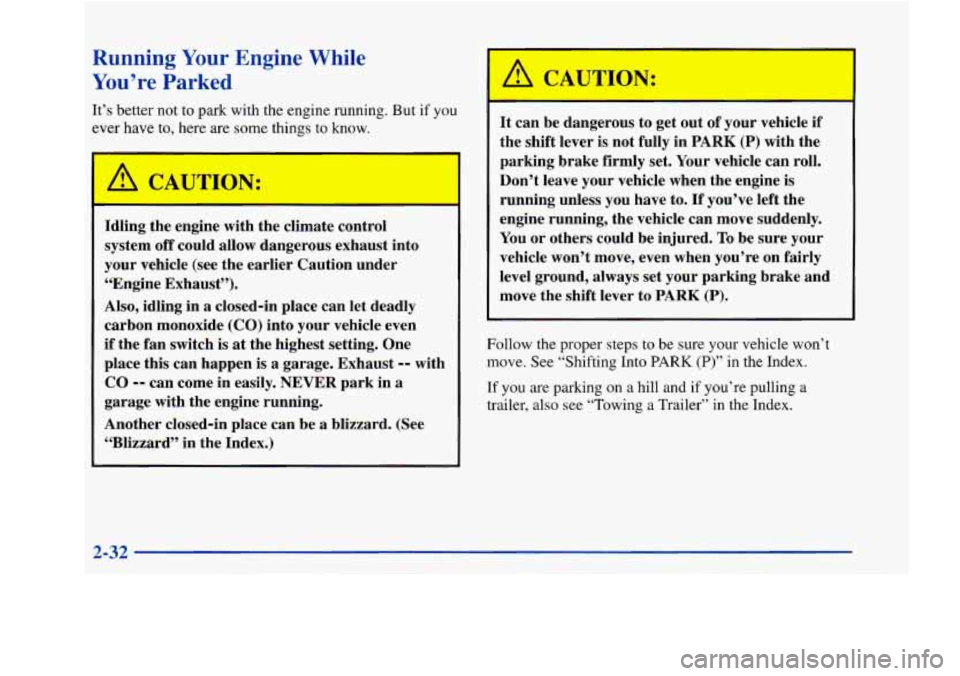
Running Your Engine While
You’re
P-_- I-ed
It’s better not to park with the engine running. But if you
ever have to, here are
some things to know.
A
/L CA 7ON:
Idling the engine with the climate control
system
off could allow dangerous exhaust into
your vehicle (see the earlier Caution under
“Engine Exhaust”).
Also, idling in
a closed-in place can let deadly
carbon monoxide
(CO) into your vehicle even
if the fan switch is at the highest setting. One
place this can happen is
a garage. Exhaust -- with
CO -- can come in easily. NEVER park in a
garage with the engine running.
Another closed-in place can be a blizzard. (See
“Blizzard” in the Index.)
-
It can be dangerous to get out of your vehicle if
the shift lever is not fully in PARK (P) with the
parking brake firmly set. Your vehicle can roll.
Don’t leave your vehicle when the engine is
running unless you have to.
If you’ve left the
engine running, the vehicle can move suddenly.
You or others could be injured.
To be sure your
vehicle won’t move, even when you’re on fairly
level ground, always set your parking brake and
move the shift lever to PARK
(P).
Follow the proper steps to be sure your vehicle won’t
move. See “Shifting Into
PARK (P)” in the Index.
If you are parking on a hill and if you’re pulling a
trailer, also see “Towing a Trailer’’ in the Index.
Page 100 of 380
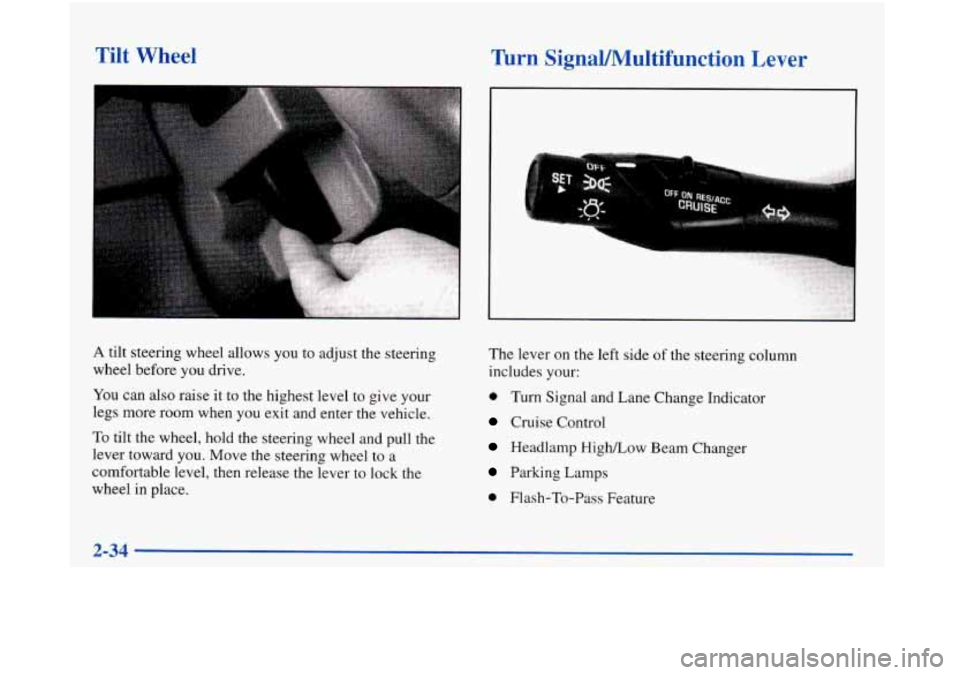
Tilt Wheel Turn SignaVMultifunction Lever
.. ::..,". .: ..:. s;r:
A tilt steering wheel allows you to adjust the steering
wheel before you drive.
You can also raise it to the highest level to give your
legs more room when you exit and enter the vehicle.
To tilt the wheel, hold the steering wheel and pull the
lever toward you. Move the steering wheel to a
comfortable level, then release the lever
to lock the
wheel in place. The
lever on the left side
of the steering column
includes your:
0 Turn Signal and Lane Change Indicator
Cruise Control
Headlamp High/Low Beam Changer
Parking Lamps
0 Flash-To-Pass Feature
2-34
Page 103 of 380
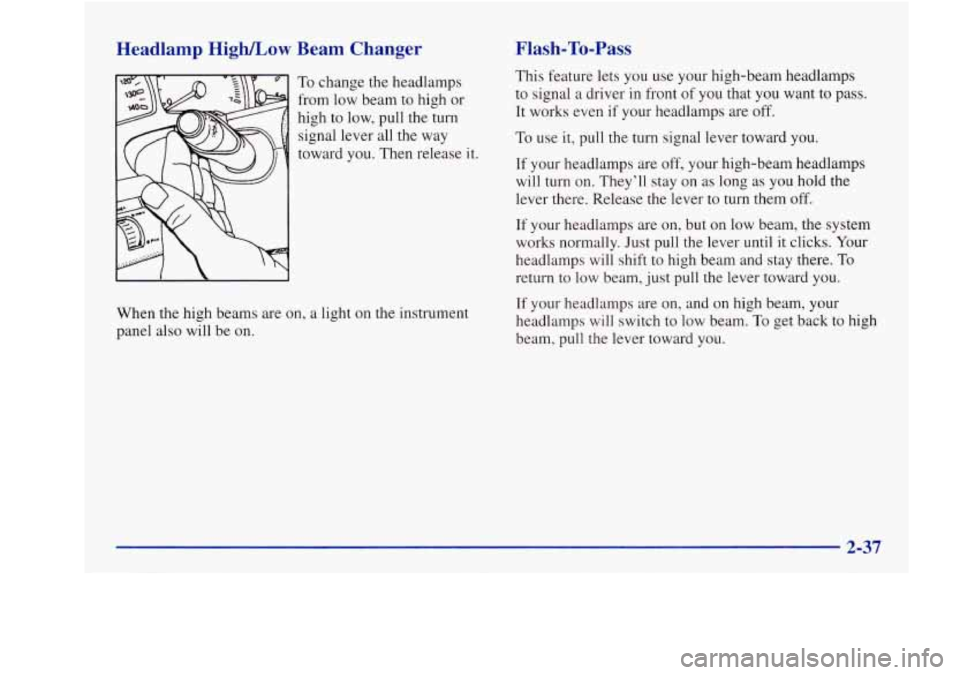
Headlamp High/Low Beam Changer
To change the headlamps
from low beam to high or
high to low, pull the turn
signal lever all
the way
toward you. Then release it.
When the high beams are on, a light on the instrument
panel also will be on.
Flash-To-Pass
This feature lets you use your high-beam headlamps
to signal a driver in front of you that you want to pass.
It works even if your headlamps are off.
To use it, pull the turn signal lever toward you.
If your headlamps are off, your high-beam headlamps
will turn on. They’ll stay on as long as you hold the
lever there. Release the lever to turn them off.
If your headlamps are on, but on low beam, the system
works normally. Just pull the lever until it clicks. Your
headlamps will shift
to high beam and stay there. To
return to low beam, just pull the lever toward you.
If your headlamps are
on, and on high beam, your
headlamps will switch
to low beam. To get back to high
beam, pull the lever toward you.
Page 104 of 380
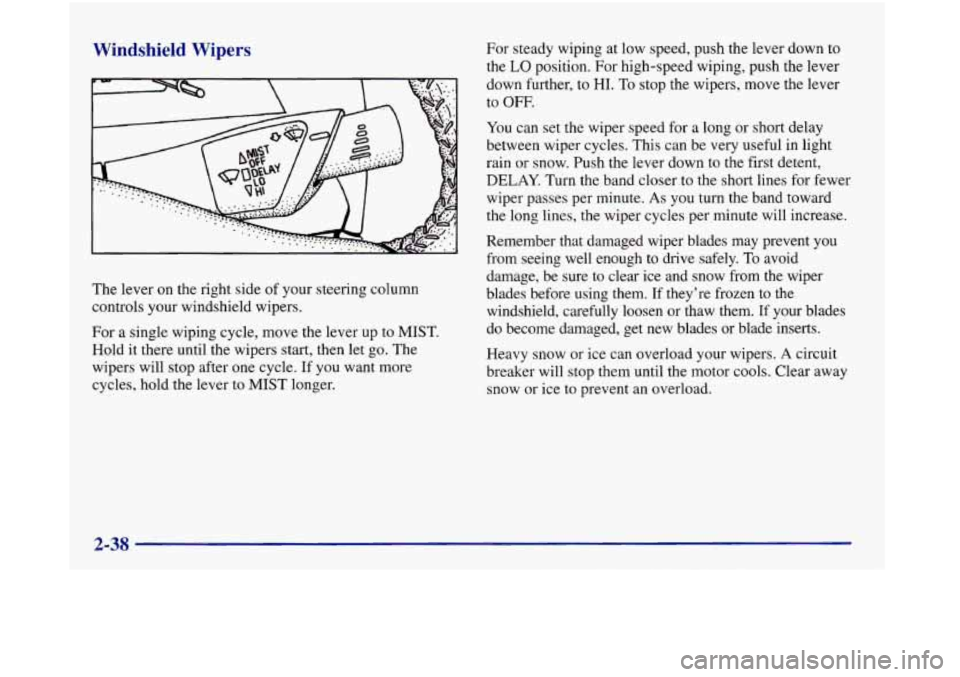
Windshield Wipers
The lever on the right side of your steering column
controls your windshield wipers.
For a single wiping cycle, move the lever up to
MIST.
Hold it there until the wipers start, then let go. The
wipers will stop after one cycle.
If you want more
cycles, hold the lever to
MIST longer. For steady wiping at low speed, push the lever down
to
the
LO position. For high-speed wiping, push the lever
down further, to HI.
To stop the wipers, move the lever
to OFF.
You can set the wiper speed for a long or short delay
between wiper cycles. This can be very useful in light
rain
or snow. Push the lever down to the first detent,
DELAY. Turn the band closer to the short lines for fewer
wiper passes per minute.
As you turn the band toward
the long lines, the wiper cycles per minute will increase.
Remember that damaged wiper blades may prevent you
from seeing well enough to drive safely. To avoid
damage, be sure to clear ice and snow from the wiper
blades before using them.
If they’re frozen to the
windshield, carefully loosen or thaw them. If your blades
do become damaged, get new blades or blade inserts.
Heavy snow or ice can overload your wipers.
A circuit
breaker will stop them until the motor cools. Clear away
snow or ice to prevent an overload.
2-38
Page 105 of 380
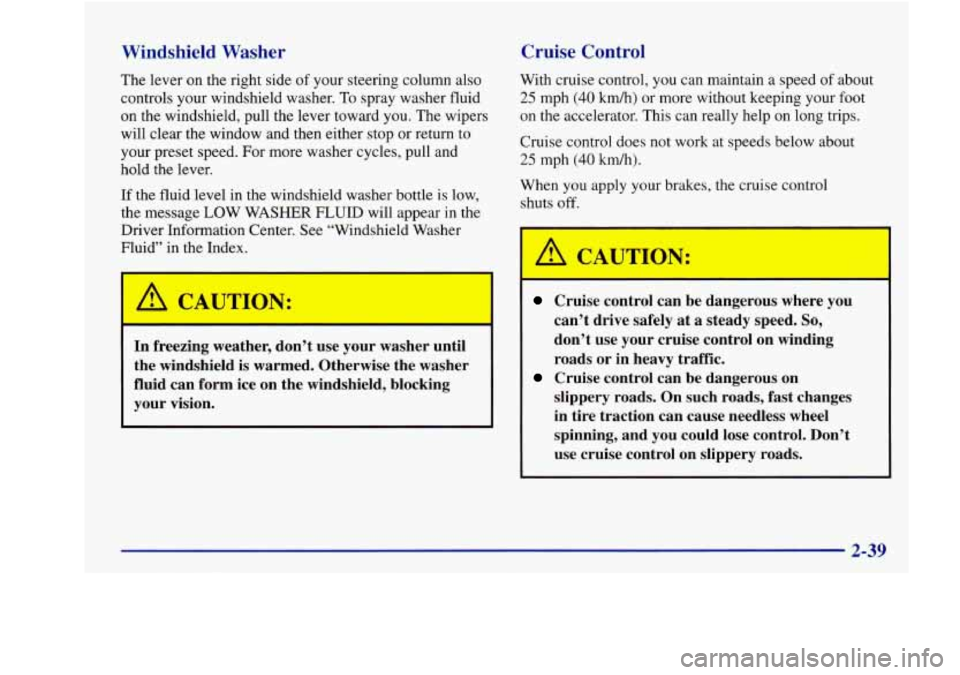
Windshield Washer Cruise Control
The
lever on the right side of your steering column also
controls your windshield washer. To spray washer fluid
on the windshield, pull the lever toward
you. The wipers
will clear the window and then either stop or return to
your preset speed. For more washer cycles, pull and
hold the lever.
If the fluid level in the windshield washer bottle is low,
the message LOW WASHER
FLUID will appear in the
Driver Information Center. See “Windshield Washer
Fluid” in the Index.
In freezing weather, don’t use your washer until
the windshield is warmed. Otherwise the washer
fluid can form ice on the windshield, blocking
your vision.
With cruise control, you can maintain a speed of about
25 mph (40 km/h) or more without keeping your foot
on the accelerator. This can really help on long trips.
Cruise control does not work at speeds below about
25 mph (40 ludh).
When you apply your brakes, the cruise control
shuts
off.
Cruise control can be dangerous where you
can’t drive safely at
a steady speed. So,
don’t use your cruise control on winding
roads or in heavy traffic.
slippery roads. On such roads, fast changes
in tire traction can cause needless wheel
spinning, and you could lose control. Don’t
use cruise control on slippery roads.
Cruise control can be dangerous on
Page 109 of 380
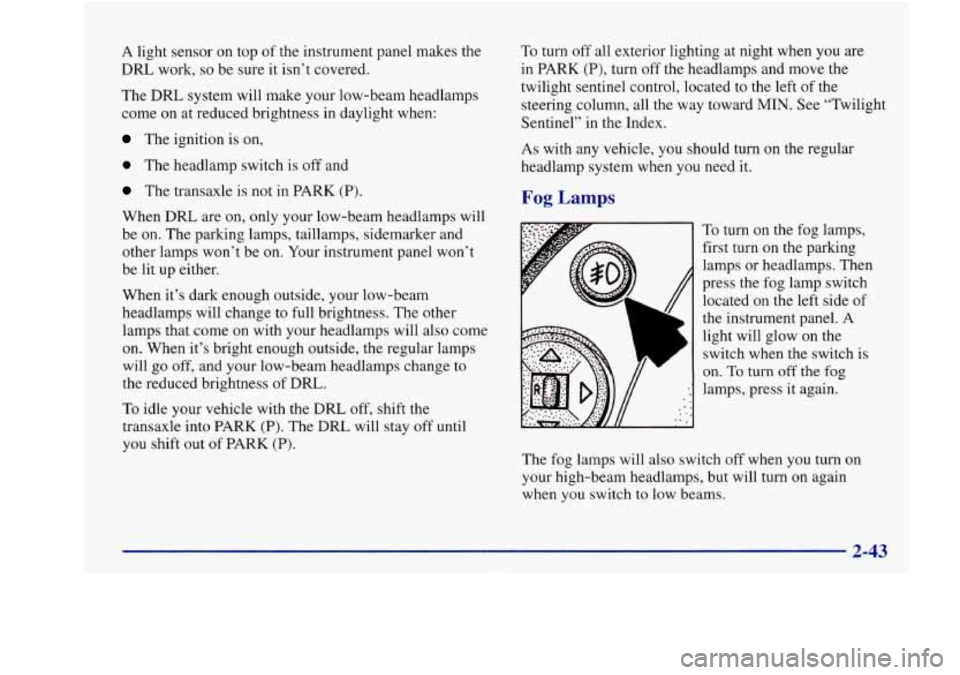
A light sensor on top of the instrument panel makes the
DRL work,
so be sure it isn’t covered.
The DRL system will make your low-beam headlamps
come on at reduced brightness in daylight when:
The ignition is on,
0 The headlamp switch is off and
The transaxle is not in PARK (P).
When DRL are on, only your low-beam headlamps will
be on. The parking lamps, taillamps, sidemarker and
other lamps won’t be on. Your instrument panel won’t
be lit up either.
When it’s dark enough outside, your low-beam
headlamps will change to full brightness. The other
lamps that come
on with your headlamps will also come
on. When it’s bright enough outside, the regular lamps
will go off, and your low-beam headlamps change
to
the reduced brightness of DRL.
To idle your vehicle with the DRL off, shift the
transaxle into PARK (P). The DIU will stay off until
you shift out of PARK
(P).
To turn off all exterior lighting at night when you are
in PARK (P), turn off the headlamps and move the
twilight sentinel control, located to the left of the
steering column, all the way toward
MIN. See “Twilight
Sentinel” in the Index.
As with any vehicle, you should turn on the regular
headlamp system when you need it.
Fog Lamps
To turn on the fog lamps,
first turn on the parking
lamps or headlamps. Then
press the fog lamp switch
located
on the left side of
the instrument panel. A
light will glow on the
switch when the switch is
on.
To turn off the fog
lamps, press it again.
The fog lamps will
also switch off when you turn on
your high-beam headlamps, but will turn on again
when you switch to low beams.
Page 110 of 380
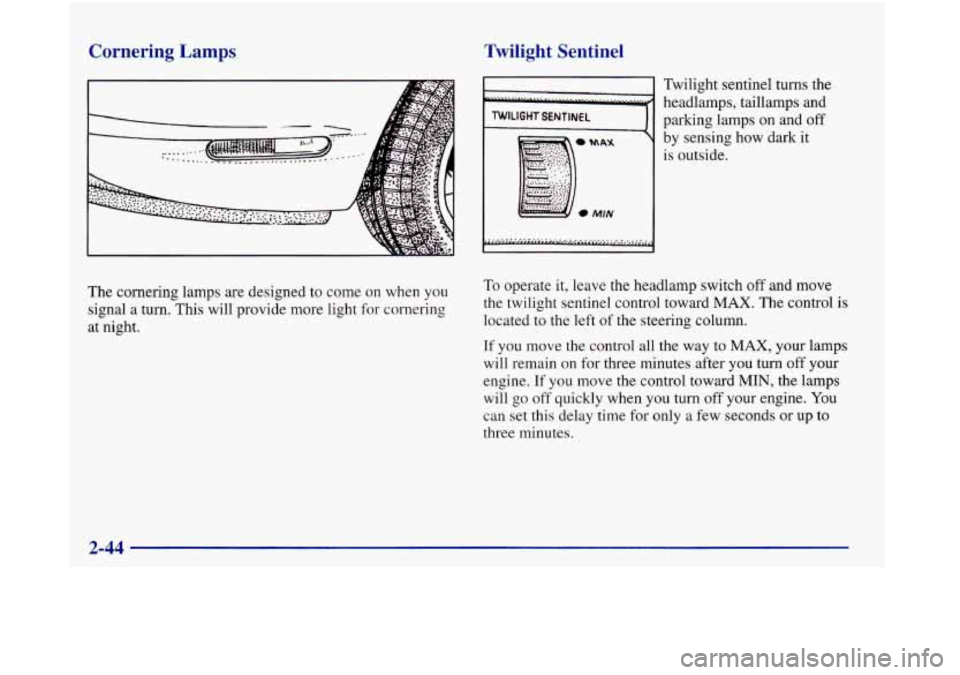
Cornering Lamps
The cornering lamps are designed to come on when you
signal a turn. This will provide more light for cornering
at night.
Twilight Sentinel
Twilight sentinel turns the
headlamps, taillamps and
TWILIGHT SfNTlNEL
II parking famps on and off
by sensing how dark it
is outside.
To operate it, leave the headlamp switch off and move
the twilight sentinel control toward MAX. The control is
located to the left of the steering column.
If you move the control all the way to MAX, your lamps
will remain on for three minutes after you turn
off your
engine. If you move the control toward MIN, the lamps
will go off quickly when you turn off your engine. You
can set this delay time for only a few seconds
or up to
three minutes.